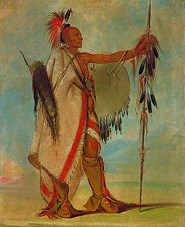Part of a series of articles titled Fort Scott History.
Article
The Osage

Children of the Middle Waters
A spiritual people, the Osage refer to themselves as Ni-u-kon-ska or People of the Middle Waters. Osage religious beliefs are based on Wah-kon-tah, the great mystery spirit or power. In Osage oral traditions, the People of the Sky (Tzi-sho) met with the People of the Earth (Hun-Kah) to form one tribe, the Children of the Middle Waters (Nee Oh-kah-shkahn). The ancestral Osage were excellent hunters and a powerful nation. Osage Indians originally lived in villages primarily along the Osage River, roaming the land between three great rivers, the Missouri to the north, the Mississippi to the east, and the Arkansas to the south. Their western boundary stretched into the windswept plains where they hunted buffalo. The site of Fort Scott is located on traditional Osage homeland.
Osage Lifestyle
Before the arrival of Europeans, the Osage obtained food by hunting, gathering, and farming. Osages hunted wild game such as bison, elk, and deer. They also constructed arch-oval structures with smoke holes using timber, woven mats, buffalo hide, and bark sheets. These structures stood 36-100 feet high. There were two bison hunts a year, one in the summer and one in the fall. The goal of the summer hunt was to obtain meat and fat. The purpose of the fall hunt, in addition to obtaining food, was to obtain the thick winter coats of the bison for making elaborate robes, moccasins, leggings, dresses, and forms of clothing. In Osage society, only the men hunted while women did the work of butchering, preparing meat, and tanning hides.

George Catlin
Historic Encounters on Canvas and Text
During his career, well-known artist, George Catlin, traveled around the west and painted portraits of Native Americans. In 1834, he painted several Osage on canvas at Fort Gibson, Oklahoma. This included the standing portrait of, Tchong-tas-sab-bee, Chief Black Dog in full Osage regalia holding traditional devices and weapons. Catlin would go on to create additional portraits and paintings that showed intricate detail of Osage family life, subsistence, and warriors. Through his work, Catlin continued capturing the lifeways of fifty tribes west of the Mississippi. His collection was donated to the Smithsonian Institution in 1879 where it resides today.
Victor Tixier, a Frenchman, traveled to the Americas in 1840 and visited the western prairies of the Osage. There, Tixier was fascinated with Osage lifeways and documented his experience. While immersing himself into their culture, he described Osage medical practices, rules, hospitality, dwellings, foodways, fishing, and hunting practices at length in his book, Voyage aux Prairies Osages, Louisiana et Missouri, 1839–40. His descriptions are considered invaluable in the documentation of Osage lifeways during the 1840s.
Other explorers like Louis Cortambert also interacted with the Osage. In 1836, Cortambert wrote about his experience. Like Tixier, his historic interactions provide us with further documentation into Osage lifeways of that time period.
Osage Relocation
The ancestral homelands of the Osage were part of the immense Louisiana Purchase that the United States acquired in 1803. Missouri achieved statehood in 1821, and soon after, over 5,000 Osage were removed west to the 'Indian Territory'. Other Native American tribes from the eastern US were also relocated west of the Missouri and Arkansas boundaries. Federal troops were stationed in this “Permanent Indian Territory” to keep the peace. After Kansas opened for settlement in 1854, many Native American Tribes were again relocated. By 1872, American settlers forced the Osage to relinquish most of their remaining ancestral homelands and relocate to Pawhuska, Oklahoma. The Osage Nation today continues to be a strong nation that maintains many of their traditional lifeways.
Last updated: February 14, 2025
